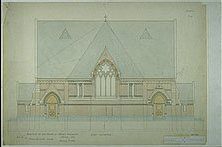

|
Charles Babcock. Sage
College. |
Charles Babcock served as Cornell’s first professor of
architecture and dean and director of the School of Architecture from 1871 until 1896. He
was born in 1829 in Ballston Spa, New York. After receiving A.B. and A.M. degrees in
Classics from Union College, he served an apprenticeship with Richard Upjohn. He assisted
Upjohn in the construction of Trinity Church in New York City, the work that established
Upjohn’s preeminence among American architects of the period. In 1857, Babcock became
one of the founding members of the American Institute of Architects. He was deeply
influenced by Upjohn’s interest in Gothic Revivalism, which seems to have led him to
study for the ministry. In 1864 Babcock became an Episcopal priest and rector of St.
John’s Church in Greenwood Iron Works (now Arden), New York. Under Babcock, Cornell’s curriculum was based on John Ruskin’s notion that "before an architect can become a true artist, he must be a master of the art of building and a man of science." Babcock taught a variety of courses, including building technology, structures, mechanics, and architectural history, but he did not teach design until the third year. Until 1880 Babcock was the Architecture Department’s only professor. In addition to his teaching and administrative responsibilities, he also completed two textbooks, Elementary Architecture (1876) and Vaults (1884), and developed an extensive set of illustrations for the history of architecture and construction. Additionally, he organized and served as the rector of St. Paul’s Episcopal Church, which held services in Sage Chapel. |
|
Charles Babcock. “Byzantine and Romanesque
Architecture.“ |
|
 Charles Babcock. Sage Chapel. East Elevation. February 1, 1898. |